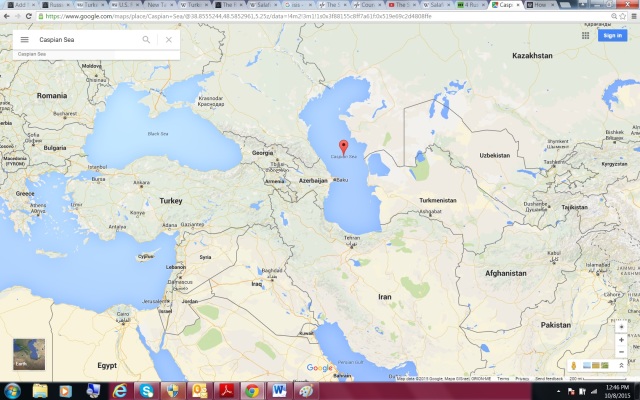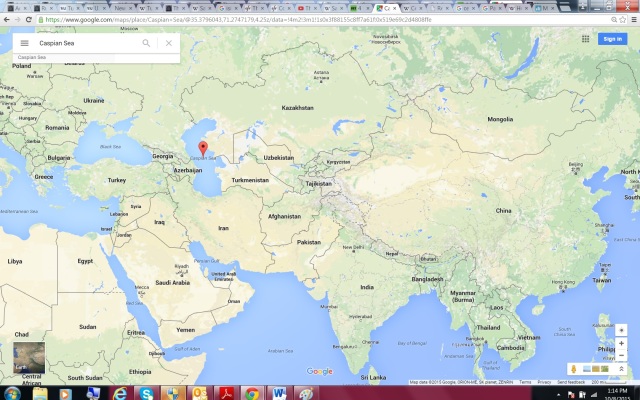I hardly know where to start with this post; so many bits of knowledge are swimming around in my head.
First, I think something really significant is happening in the Middle East right now. Lots of pieces that have been in motion and slowly gathering separate momentums (momenta?) for a few years seem to be coalescing into one giant paroxysm of violence in Syria and Iraq.
At best, a major power shift is occuring. Worst case: this is the start of World War III. No kidding.
I hope I’m wrong about that second one. I hope we’ve learned enough as a people (that is, as members of the one human race) to avoid making the same horrific mistakes of our past.
So here’s a basic summary of my vague fears.
1) Russia needs a stable Syria and a stable Turkey and a friendly, Russia-oriented (not Europe-oriented) Crimea in order to maintain the stability of its Black Sea Fleet—which is its only warm water naval base. Russia needs Crimea because that’s where the Black Sea Fleet is based, in the city of Sevastopol. They need Turkey because the only way to get from the Black Sea out to the rest of the world is via the Turkish Straits. And they need Syria because of the naval refueling station in the Mediterranean coastal city of Tartus. About a year and a half ago I wrote a blog post analyzing this situation, complete with maps. You can link to it here for additional background.
2) Just as happened in World War I, two distinctive “sides” seem to be forming, based on previous alliances and old ethnic sympathies/hatreds.
Russia is allied with Syrian president Bashar al-Assad. One little twist on this story is that Assad ascended to his position as Syria’s president through ascription—i.e., hereditary inheritance of political office and power, similar to the family dynasty in North Korea. Assad’s father was Syria’s previous president-for-life (1971–2000). So part of what started the internal strife in Syria in the first place was the question of Assad’s legitimacy and authority to govern.
Anyway, Russia and Iran both have troops on the ground in Syria now, ostensibly fighting ISIS/ISIL (Islamic State of Iraq and Syria / Islamic State of Iraq and the Levant). Iran’s involvement fighting ISIS on Iraqi soil is also welcomed by the Shiite-led Iraqi government.
Remember the Iran–Iraq war? That was another time, another political reality. The Iraqi government was then run by Sunnis, adherents of a denomination of Islam that was (and remains) in the minority of Iraq’s overall population, far outnumbered by Shia Muslims. Sunnis and Shiites despise each other, despite the fact that they are both branches of Islam. Most Muslims in the world are actually Sunni, but guess where most of the Shia live? Iraq and Iran (and Pakistan and India).
ISIS/ISIL is Sunni. Actually they are Salafi jihadists, which is like saying they are über-Sunni fundamentalist followers of the one true Sunni way—and not just fundamentalists but radical fundamentalists to boot, who believe in an interpretation of “jihad” that requires not just living according to Islam or building a society based on Islam but actually fighting a holy war against all perceived enemies of Islam. Actually not even enemies of Islam but enemies of the one true Islam which would be Sunni. Actually not even Sunni but the one true Sunni, which would be Salafi. Does that make sense?
Iran (Shia) doesn’t like ISIS/ISIL (über-Sunni).
Iraq (now Shia, and actually always Shia in population but long suppressed by the Sunnis, who dominated Iraq’s government, except now the shoe is on the other foot, with a democratically elected Shia government representing a Shia-majority population), yes, Iraq is now friends with Iran. At least “friendly,” anyway.
Sunni Iraqis have been somewhat sympathetic toward and supporting of ISIS. Shia Iraqis don’t like that. Enter Iran, but quietly, so as not to stir up tensions between Iraq’s Sunnis and Shiites. For over a year Iran has been providing technical assistance and training to Iraqi troops, plus it has reportedly been secretly funding Shia militia groups who are fighting ISIS.
Saudi Arabia is Sunni, with a tiny Shia population and a very sizable segment of über-Sunni adherents of Salafism, also known as Wahhabism. (Don’t forget that ISIS is Salafi.)
So, the Islamic world is basically divided up into these two groups, Sunni and Shia, who despise each other.
Here’s a really nice video explaining the Sunni–Shia divide, produced by the Council on Foreign Relations.
3) (Remember #s 1 and 2? They were so long ago in this post 🙂 ) Russia has just begun launching missiles at ISIS targets from warships in the Caspian Sea. Here’s a screen shot I took of the Caspian Sea on Google Maps. (Look for the red “pin” marking it in the middle of the map.)
This is an interesting place for Russia to be firing missiles from—mostly because I’ve been watching Central Asia for a while now, ever since reading S. Frederick Starr’s brilliant 2009 Wilson Quarterly essay, “Rediscovering Central Asia.” (Link to the essay here.)
Once home to the Silk Road (the original, that is), not only is Central Asia blessed with tremendous reserves of oil and natural gas of its own, but it is also by virtue of its location a place across which many other nations would like to transport oil and gas via pipelines. Central Asia is huge and is bordered by Russia, China, Southeast Asia, and the Middle East.
So does Russia’s using the Caspian Sea to fire missiles have any greater significance? Is it merely because firing from the Black Sea would be too blatantly a violation of Turkey’s airspace? Or does originating missile fire from the Caspian Sea also serve to remind those nations surrounding it that Russia does indeed have powerful military strength? Don’t forget that Russia has experienced several Islamic terrorist attacks committed by Central Asians.
Yes, Central Asia is largely Muslim, and mostly Sunni at that. Only Afghanistan and Tajikistan have sizable Shia populations, although even then Shias are a minority.
Most of the world’s Muslim population, in fact, is Sunni. The Sunni Muslims are spread throughout Africa, Central Asia, and the South Pacific (Indonesia, etc.). The Shia population is concentrated mainly in four countries: Iraq, Iran, Pakistan, India.
Here’s another screen shot of Central Asia (thanks Google Maps 🙂 ). The shortest, most direct way for Central Asian oil and gas to get to the ocean for transport is to run pipelines directly south—through Iraq, Iran, Pakistan, India. Sort of a Shia rampart standing guard and blocking Central Asia’s way to the Indian Ocean. Okay, that’s an overstatement. But looking at the map, you can see that countries bordering Central Asia and blocking its pipeline/pathway to Europe and to the sea suddenly become both powerful and vulnerable.
Does this post make sense to you? It’s all still a jumble to me, and there are more details than these that feed into my worries.
For example, when the current civil war began in Yemen (Wikipedia article here), my Saudi students told me about the “Shiite crescent,” which is a theory subscribed to by many Sunnis in the Arab world that basically holds that Iran is trying to establish a “crescent” of influence from Lebanon to the Persian Gulf.
Depending on your perspective you may view this “Shiite crescent” idea as a mere conspiracy theory, with all the accompanying paranoia that such theories tend to engender. But it’s a a subject that has gotten scholarly attention, and here is a good article from the Brown Journal of World Affairs (Fall/Winter 2008) that provides some background information: “Iran and the Shiite Crescent: Myths and Realities.”
So to wrap up this post and recap my main concern: Are we on the verge of a new worldwide conflict in which “entangling alliances” based on the internal combustion engine and plastic packaging will drag reluctant (hapless?) nations into a long-simmering cauldron of Sunni–Shia hatred—and spread over an even broader geography than ever before thanks to hubris and 21st-century technology?
I certainly hope not.





Nice post, thanks. I think it’s difficult to draw exact comparisons. Russia is certainly interested in establishing some sort control over that area, for the reasons you outlined. The other major powers seem to be content with a more limited involvement.
Are you familiar with Dan Carline? His podcast outline of the origin of World War I does a brilliant job of explaining how the killing of a relatively minor figure inexorably drew the major powers into war. http://www.dancarlin.com/product/hardcore-history-50-blueprint-for-armageddon-i/
LikeLike
I’m not familiar with Dan Carline’s work, but that kind of background analysis fascinates me. It’s why I love history: It’s so much easier to understand what’s happening today if you understand what has come before. Thanks for telling me about Carline. I’ll check him out!
LikeLike
Wow. I learned so much from your descriptions. I have much more focused on US policy and domestic disturbances. I guess we can’t be isolationists saying “Let them sort it out themselves. It’s none of our business” anymore. ………………or can we?
LikeLike
That’s what we seem to be doing. Which is kind of our default: non-interventionism, despite the simultaneous reputation we have for imperialist ambitions and trying to “police” the world. That’s my take anyway.
What makes me nervous is that we also don’t WANT to recognize or acknowledge the bad news that something is happening that will pull us in whether we want to be there or not. I’d rather have my eyes open and make the decision to take action myself than be blissfully ignorant and have my first inkling of trouble come when it’s too late to protect myself.
LikeLike
It is all such a complex and terrifying mess. I think you’d enjoy (if that’s the right word) a book I was able to read a pre-publication copy of recently, The ISIS Apocalypse, by William McCants (http://us.macmillan.com/theisisapocalypse/williammccants), that discusses how apocalyptic differences in Sunni/Shi’a beliefs play into what is going on, as well as the related histories of the many branches of Al Qaeda, the Taliban, and the Islamic State. He wrote a short adaptation of it here: http://www.politico.com/magazine/story/2015/08/isis-jihad-121525
LikeLike
Thanks, Lisa! I followed your link to this article, and the background on ISIS leadership and their internal politics was bery enlightening.
LikeLike
What a scary world that most of us do not understand in the least!! Tha’ts what most war is about, anyway, lack of understanding, tolerance and compassion. That’s probably just me being naive.
LikeLike
Lack of tolerance, understanding, and compassion AND, too often, a smug belief that God is on their side. One can only hope that a very unpleasant reckoning awaits those who drag Him through the mud that way 😄
LikeLike
Pingback: Some background on Turkey within the Middle East conflicts | Katherine Wikoff